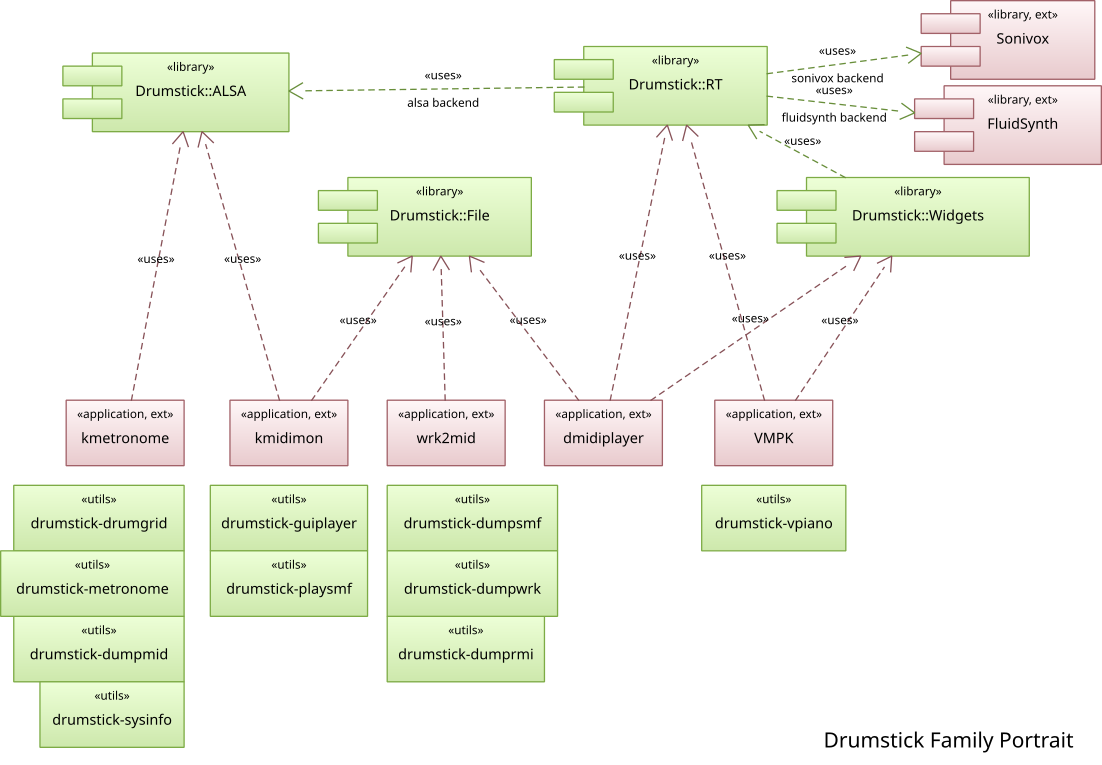A new batch of releases from the last weekend: Drumstick libraries 2.4.0, Drumstick Multiplatform MIDI File Player 1.5.1 and Drumstick MIDI Monitor 1.1.0 are out, and here are the main changes for each one:
Drumstick Libraries v2.4.0:
- implemented ticket #29: RIFF RMID file support. New utility dumprmi, and guiplayer updated.
- implemented ticket #32: missing library version functions in File and RT libs
- implemented ticket #33: versioninfo object for windows libraries
- Enabled by default the internal reverb on macOS DLS Synth
- Avoided hardcoded font family name in vpiano
Drumstick Multiplatform MIDI File Player v1.5.1:
- Fixed GH ticket #6: The dependency target "update_helpfiles" of target "dmidiplayer" does not exist. The pandoc utility is optional again.
- Fixed error checking of DwmGetWindowAttribute() call. This caused a problem in Windows 7 running the "Windows Classic" theme.
- Support for RIFF MIDI files, provided by Drumstick 2.4.0
- Czech manual updated, thanks to Pavel Fric
Drumstick MIDI Monitor v1.1.0
- Removed warnings building with Qt >= 5.15
- MIDI texts/lyrics encoding defaults to Latin1
- New options: Qt Style, Dark mode, and internal icon theme based on breeze
- CMake version >= 3.14
- Added SCM Revision to the about box
- Fixed file info dialog (initial tempo, ...)
- Support for RIFF RMID (.rmi) file format
A common point for all the above is the RIFF MIDI file format support. Citing the LOC:
It is a wrapper format for MIDI data, as first specified by Microsoft, and later extended by MIDI.org (an arm of the MIDI Manufacturers Association) to permit the bundling of both MIDI files and Downloadable Sounds (DLS) files. According to Multimedia Programming Interface and Data Specifications 1.0, August 1991.: "The 'RMID' format consists of a standard MIDI file enclosed in a RIFF chunk. Enclosing the MIDI file in a 'RIFF' chunk allows the file to be consistently identified; for example, an 'INFO' list can be included in the file."
The RIFF format specifications were published in 1991 in Microsoft Windows Multimedia Programmer's Reference, with a brief section devoted to RMID (8-31). The extended specification that documented how both MIDI and downloadable sounds could be bundled in an RMID file (technical note RP-029, "Bundling SMF and DLS data in an 'RMID' File"), was published by the MIDI Manusfacturers Association (MMA) in 2000. The co-authors represent IBM Research, Kurzweil, Microsoft, and Sonic Foundry. In 2001, MMA published the XMF_1_0 specification, which they now prefer to RMID.
The implementation in Drumstick::File offers read-only functionality, and requires the existing SMF class to process the MIDI data portion. The DLS processing is missing, because I've been unable to find a single example of usage, and I suspect that nobody has used it in the real world. Anyway, there is a new utility 'drumstick-dumprmi', which is similar to the other commandline utilities printing the file contents as text in the terminal, with the extra functionality of extract/convert the MIDI data into a standalone SMF file.
Last month was published another utility: wrk2mid v1.0.0 which converts WRK Cakewalk files into SMF. This is something that can be done in Windows using the program Cakewalk by BandLab, which is gratis as a beer, but 'wrk2mid' can be compiled and run on Linux and macOS, so maybe it could be useful for someone. I don't expect to see it on Linux distributions any time soon, though. See: https://wrk2mid.sourceforge.io/
There was a post from 2014 with a diagram of the relationship between the Drumstick libraries v1.0 and applications at the time. Now, all my applications depend on Drumstick v2.x and there are new ones too, so may be this is a good time to paint the new picture...

The new picture
It is a pending subject to renew the repertoire included in dmidiplayer as sample songs. Here is a future one, rendered on macOS (Mojave) using dmidiplayer v1.5.1 with FluidSynth v2.2.3 and GeneralUser Soundfont.
The song is "Negra Sombra" with lyrics by Rosalia de Castro (1837-1885), published in 1880 in her book "Follas Novas", and music by Xoan Montes (1840-1899), a composer from my own birthplace (Lugo). The song was premiered in La Habana, Cuba, in 1892. You may recognize the melody if you like choral music, or because an arrangement by Carlos Nuñez and Luz Casal was included in the soundtrack of the Spanish drama film "The Sea Inside" (2004, Spanish: Mar adentro). This rendition is derived from a score and MIDI sequence by Lalus fecit edition 2013 licensed as CC-by-nc-sa.
Publishing this song at YouTube triggered the algorithm claiming it as a copyrighted work by Sony. I am not monetizing my videos at YouTube so it doesn't matter in practice, but it bothers me a lot so I'm disputing the claim. Google and Sony are taking a work that is in the public domain, and they are appropriating it. That may be seen as criminal conversion, or at least cultural appropriation.
No comments:
Post a Comment